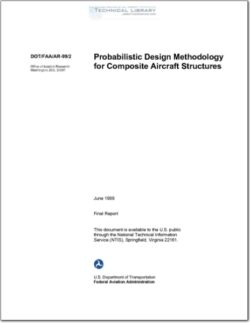DOT-FAA-AR-99-2

- Version
- 247 Downloads
- 1.29 MB File Size
- 1 File Count
- March 24, 2016 Create Date
- March 24, 2016 Last Updated
Probabilistic Design Methodology for Composite Aircraft Structures

It appears inevitable that the aerospace industry, as well as many other industries, will eventually
incorporate probabilistic analysis methods to some degree. Probabilistic structural analysis
methods, unlike traditional methods, provide a means to quantify the inherent risk of a design
and to quantify the sensitivities of design variables. The degree to which these methods are
successfully applied depends on addressing the issues and concerns discussed in this report.
Certainly, one issue is to disseminate familiarity and basic understanding of this technology.
This report is intended to introduce the subject of probabilistic analysis (also known as
probabilistic design) to engineers in the aerospace industry as well as act as a reference to guide
those applying this technology. The level of mathematical complexity is aimed at those with
limited statistical training; numerous references are given throughout that point to more elaborate
details of the methods.
Section 1 of this report explains shortcomings of the current structural analysis approach and the
potential for improvement Via incorporation of probabilistic analysis methods. The evolution of
probabilistic analysis is given in section 2, dating back to the 1940’s when A.G. Pugsley first
proposed correlating loads and strengths with structural accident rates. The basic theory of
probabilistic analysis is discussed and explained via examples in section 3, and the four major
techniques (integration, simulation, response surface, and limit state approximation) for
assessing structural reliability are introduced.
Section 4 tells who has been using the probabilistic approach and lists specific design analysis
applications. An in-depth look at one industry method (Northrop Grumman Commercial
Aircraft Division) is given in section 5. A consensus on the benefits and limitations of the
probabilistic approach from numerous authors who have published technical reports in the field
is presented in sections 6 and 7, respectively.
| File | Action |
|---|---|
| DOT-FAA-AR-99-2 Probabilistic Design Methodology for Composite Aircraft Structures.pdf | Download |
Comment On This Post